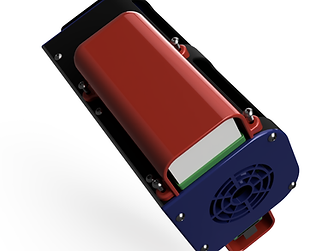
Heli Interface Unit (HIU)
This page is split into three main sections:
Parts Guide
Print Guide
Build Guide
The ultimate printer I can recommend is the Bambu Labs X1 carbon with AMS or P1P if you have deep pockets. ($1200). It's a massive leap forward in 3D printing, with excellent quality and impressive speeds. It's pretty much press print and go as the software and hardware do the calibration before each print.


Under Prototyping
Designed to house all the electrical components in one place. This includes the 4 TB6600 drivers (the fourth for the upcoming pedals), the Leo Bodnar and Arduino Mega boards. The drivers are cooled by a 60mm fan powered by 24v. In testing, I connected all the fans to 12v instead of 24v, reducing the noise greatly, and the motors all seem cool still.
General Information:

Build Guide

Click on image for more details
STEP:
0
Please download the files here by clicking the link below:
https://031b6b45-11f6-46a7-ab8e-17be9aef4dad.usrfiles.com/archives/031b6b_48aec942b31a4fbd8236c44f724ac7d5.zip
The wiring and programming guide can be found here:
https://www.737diysim.com/build-guides-1/heli-controls-programming
A quick print wiring diagram can be found here:
https://031b6b45-11f6-46a7-ab8e-17be9aef4dad.usrfiles.com/ugd/031b6b_e7677154324f447995dc696b15104c9e.pdf

Click on image for more details
STEP:
1
Install the first TB6000 Driver onto the base. Ensure the heatsink fins face inboard.

Click on image for more details
STEP:
2
Use an M4 x 6mm screw to secure the unit

Click on image for more details
STEP:
3
repeat for the other end: Use an M4 x 6mm screw to secure the unit

Click on image for more details
STEP:
4
Install the remaining 3 TB6000 drivers onto the base using M4 x 6mm screws.

Click on image for more details
STEP:
5
Place the case over the top. Make sure its the right way around! there are 5 screw holes one side, and 3 screw holes along the base on the otherside.

Click on image for more details
STEP:
6
Install the case with Qty 3, M4 x 12mm screws.

Click on image for more details
STEP:
7
Turn the case around and install a further Qty 3, M4 x 12mm screws.

Click on image for more details
STEP:
8
Instal the vent end with Qty 4, M4 x 12mm screws

Click on image for more details
STEP:
9
The vent end should look like this.

Click on image for more details
STEP:
10
Install the Fan end with QTY 4, M4 x 12mm screws.

Click on image for more details
STEP:
11
Place the 60mm fan over the large orifice

Click on image for more details
STEP:
12
Use QTY 4, M4 x 35mm screws to secure both the fan guard and fan on to the fan end.

Click on image for more details
STEP:
13
Use QTY 2, M4 x 6mm countersunk screws to secure the Leobodnar mount to the case.

Click on image for more details
STEP:
14
Use m2 x 6mm screws to secure the Leobodnar BU0836 card to the mount

Click on image for more details
STEP:
15
Secure the Leo card cover with QTY 3, M4 x 8mm screws

Click on image for more details
STEP:
16
It should look like this with the usb accessible at the open end.

Click on image for more details
STEP:
17
Install the arduino mount with QTY 2, M4 x 6mm screws.

Click on image for more details
STEP:
18
Install the arduino and prototyping shield onto the mount using QTY 4, M2 x 6mm screws.

Click on image for more details
STEP:
19
Place the Arduino cover over the assembly and secure it with QTY 4, M4 x 12mm screws.